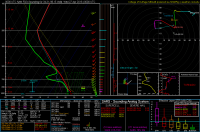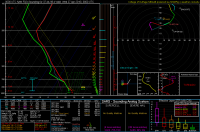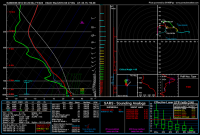Ugh, this is a very difficult forecast for me. Morning soundings and surface obs look pretty typical for a non-trivial chase day in the Plains. It looks like there will be substantial insolation today when looking at current Vis sat, which will lead to further destabilization (note that the 12z OUN sounding had ~4000 j/kg SBCAPE already). Seasonal PBL moisture and very steep lapse rates (almost dry adiabatic above the PBL and below ~5 km) substantiate the risk for very large hail.
To me, the morning runs I've examined (12km NAM, 4 km NAM, and 12-13z HRRRs) look a little more favorable for tornadic supercells than did last night's runs, with perhaps less backed mid-tropospheric flow. The chaser in me still eyes that OFB in northern KS as an obvious target. However, I'm not entirely sure I want to blast up there yet. Depending upon your particular model of choice, the environment in parts of SC KS, NW/NC OK, C OK, or SW OK / W N TX may be supportive of a substantial tornadic supercell risk later this afternoon and evening. When I click around areas from northern KS to northern TX, I can find really ugly looking hodographs on some models and some runs in some locations, but I can also find more "typical" tornadic supercell hodographs on different models and different runs in different locations.
Frustratingly, I'm no closer to choosing a target now than I was last night. I'm having a very hard time nailing down the latitude at which I think the greatest risk for a tornadic supercell exists later this afternoon or early evening.
BTW - I think Edwards and Cook wrote a fantastic 13z SWODY1 today.



